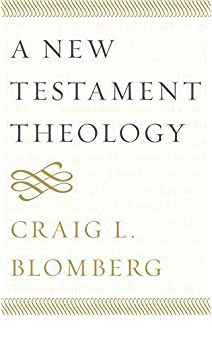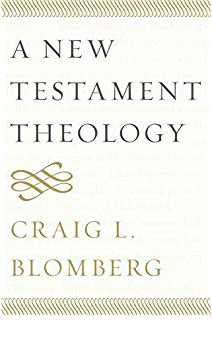Craig Blomberg, NT professor at Denver Seminary, has written about the historical reliability of the Gospels, John, and of the New Testament; commentaries on Matthew, 1 Corinthians, and James; NT introductions on the (1) Gospels and (2) Acts through Revelation. He has written two books on interpreting and preaching the Gospel parables; biblical theologies of possessions (two books on wealth, actually) and Jesus eating with sinners; on NT exegesis; an introduction on biblical interpretation; and on Premillennialism. Oh, and more. He has written numerous academic articles, general articles, some review articles, a few dictionary entries, and notes on Matthew and John in two study Bibles.
As the cap of his academic writing (that does not mean he is finished writing), Blomberg has written A New Testament Theology. This is not the definitive NT theology, only a NT theology, one focusing on fulfillment. Blomberg writes, “Every NT book states… that the age of the fulfillment of these [OT] promises has arrived. The Messiah has come. Israel’s savior has appeared. Their spiritual exile can be over. The people of Israel are being reconstituted among Jesus’ followers. A new age has been inaugurated that will embrace all people and all peoples of the world on equal terms” (11).
Rather than treating the NT topically as in Schreiner and Beale’s NT excellent theologies, Blomberg looks at the distinctive themes within each NT book (some being grouped together, but still distinct from each in that group). Blomberg looks at the canonical text. He doesn’t spend much time on how we got these texts (you can read his books on the historical reliability of the NT above). Blomberg is “much more interested in what the authors present than how they got to the point of presenting it” (13). So he doesn’t compare the NT documents with other ancient writings or their historical backgrounds and influences, except when and how they are affected by the OT. The Greco-Roman writings have little to say here. Blomberg acknowledges that there is diversity among the NT letters, but each author has his own distinctive themes and emphases.
Blomberg begins with a look at Jesus and the historical aspects that all four (but mostly Synoptics) agree on. Everything that is in Mark is basically in Matthew and Mark, and Blomberg looks here to present Jesus to his readers. Then he heads to the early church as seen in Acts. He then moves to the early Jewish Christian letters James and Jude, probably the earliest NT letters we have. Here (besides in the introduction) readers will notice that Jude is not placed with 2 Peter (which it is in many introductions and commentaries). Rather, Blomberg places 1 Peter with 2 Peter (what a novel idea). Though neither make grand announcements that the last days have arrived, the concept is implicit in these two short letters. Jesus is our grid for ethics and theology. The last days have come. False teaching has arisen in the churches. We can look to the OT to see God’s judgment on the wicked, and we can warn those who follow the false teachers that they are doomed if they continue down that crooked way.
Next comes the chapter on Paul. Blomberg believes all thirteen of Paul’s letters to be authentically Pauline. However he doesn’t treat all thirteen letters in this chapter. He sets the pastorals aside until after Luke-Acts. Many features of the pastorals match Luke and Acts, and it is possible that Luke was Paul’s amanuensis (Luke wrote what Paul dictated, and no doubt would have talked about the text with him, writing in his own style and adding his own nuances [183]). Blomberg, not wanting to abandon the distinctions between Paul’s letters. believes “the need for an overall synthesis outweighs the benefits one would gain by focusing just on the distinctives of each letter” (181). It was the same person who wrote all of these letters. The distinctions come out of the same mind who has the same worldview: Jesus Christ is the Messiah who come to earth, died, was raised, ascended to the Father, and is ruling at his right hand. Blomberg looks at the theme of fulfillment briefly in each of Paul’s letters before he looks at the unifying themes among them.
After Paul comes Mark, Matthew, Luke and Acts. What is impressive is that, in some ways, the Gospels and Acts have already been covered in the chapters on Jesus and the early church. But in these later chapters Blomberg shows what is distinctive with Mark, Matthew, and Luke, along with the similarities of Luke and Acts. The chapter on the early church had primarily to do with, well, life of the early church, their use of the OT Scripture, eschatology, salvation, and their care for the poor. His chapter on Luke and Acts focuses on the Holy Spirit, riches and poverty, the great reversal of the low being raised and the proud being humbled, the inclusion of outsiders, the view of authorities, the land, the law, the temple, discipleship, ecclesiology, and more.
Next Bomberg surveys the Pastoral Epistles, Hebrews, 1-2 Peter, and the Johannine literature. He groups John’s letters together while still keeping them distinct. Judgment is a minor theme in John, is hardly mentioned in 1-3 John, and is everywhere in Revelation.
Recommended?
Schreiner and Beale’s NT theologies are still my favorite, and there are many good theologies out there. However, Blomberg has written an excellent, hefty tome that will help many to understand the NT better. I’ve already been able to use some of it to prepare for my sermon on John this Sunday, and I know it will be on of the first ones I grab in the future. Blomberg’s method of going book-by-book helps readers to find information on a NT letter more easily. This is obvious, but important. Schreiner and Beale have written excellent NT theologies, but it can be difficult to find out their thoughts on Mark without heading straight for the Scripture Index in the back. Blomberg is not a perfect interpreter, but he has read widely, deeply, and critically. He is up to date on his information, and his NT theology is very readable and well recommended.
Lagniappe
- Author: Craig L. Blomberg
- Softcover: 769 pages
- Publisher: Baylor University Press (October 1, 2018)
Find it on Amazon!
Review Disclosure: I received this book free from Baylor University Press. The opinions I have expressed are my own, and I was not required to write a positive review. I am disclosing this in accordance with the Federal Trade Commission’s 16 CFR, Part 255 http://www.access.gpo.gov/nara/cfr/waisidx_03/16cfr255_03.html.
Amazon Affiliate Disclosure: As an Amazon Associate I earn from qualifying purchases.


Thank you for your very detailed and gracious review!
LikeLike
You are very welcome!
LikeLike
While I respect Blomberg as a person, I cannot find much of worth in his NT theology, as it makes the typical semi-fundamentalist mistakes in handling these ancient texts. A much better study is found in Arthur Bellinzoni’s The New Testament An Intro to Biblical Scholarship.
LikeLike
Hey David, what are some of Blomberg’s “semi-fundamentalist” mistakes? What does Bellinzoni add to the discussion?
LikeLike
Blomberg comes at the ancient cultic texts far more literally than is warranted by a careful comparison of similar literature from those times and places. His work really amounts to apologetics, which does not actually educate the reader. Bellinzoni’s study is HONEST historiographical inquiry into the “new testament”/christian origins. Get his book and study carefully, I trust you will be all the better informed having done so.
LikeLike
Bellinzoni largely dismisses more conservative scholarship and criticism leveled at his methods. He is only interested in critical scholarship. So no surprise that you find little ‘worth’ in Blomberg’s understanding.
LikeLike
Incorrect. Bellinzoni ONLY uses CORRECT methods in historiography. By contrast, going by Blomberg’s special pleading and apologetics methods, we’d have to also believe in many other non christian ancient fairy tales as being literally true. Bellinzoni is an HONEST scholar, its no surprise that you find little “worth” in his methods, as his methods expose the ancient christian fairy tales for the fairy tales they are.
LikeLike
In what way does Blomberg take the ancient texts more literally than is warranted? What methods does Bellinzoni use that are correct?
LikeLike
Here is a link to Bellinzoni’s book online, where you can read quite a bit of it for free. I suggest you HONESTLY (if that is possible for you) study his pages 13-22, historical method and rules of evidence, https://books.google.com/books?id=yUyPCwAAQBAJ&printsec=frontcover#v=onepage&q&f=false In a nutshell (although you will be better served reading Bellinzoni explain it), Bellinzoni comes at the ancient writings THE SAME WAY any other ancient tale full of deity claims, supernatural occurrences and deity demi-god human involvement would be approached by classics scholars and ancient historians: NOT assuming they are true or false, NOT trying to prove or disprove them. But rather, trying to apply rigorous historical methods of critical inquiry, and then letting THAT lead where it will…….. By contrast, apologists like Blomberg, come at the “new testament” FAVORING it and trying to DEFEND it. Huge difference in approaches.
LikeLike